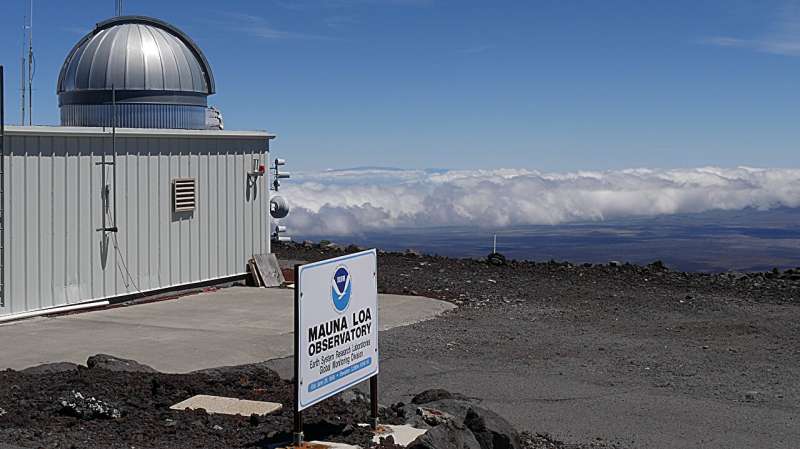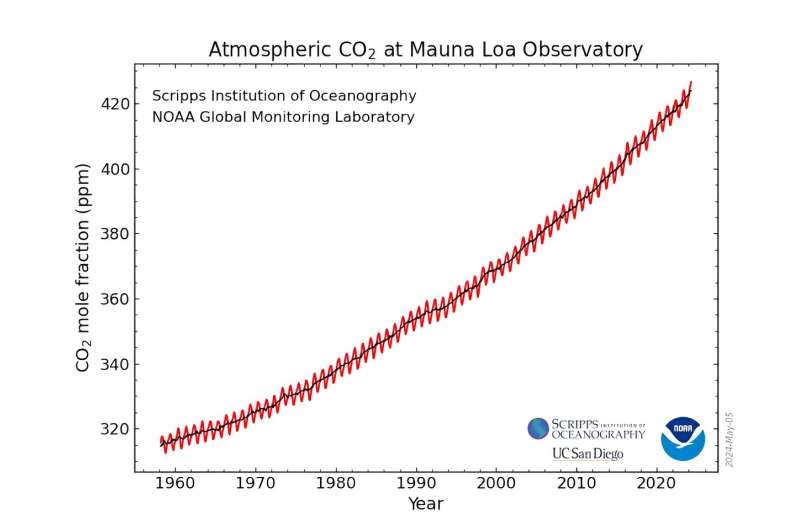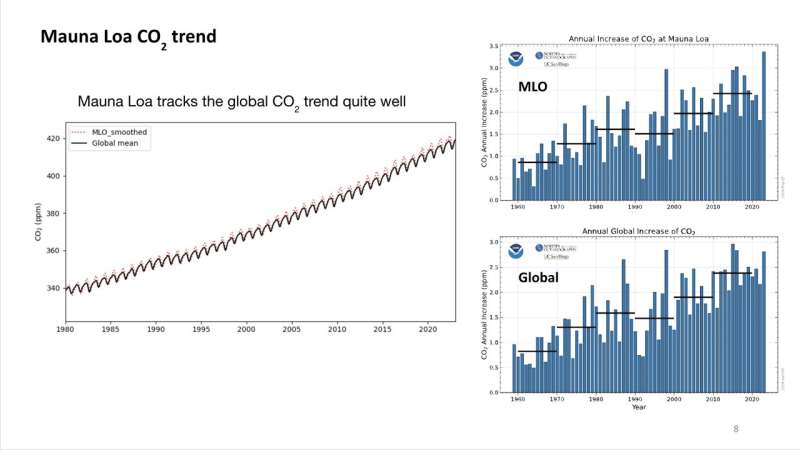This article has been reviewed according to Science X's editorial process and policies. Editors have highlighted the following attributes while ensuring the content's credibility:
fact-checked
trusted source
proofread
During a year of extremes, carbon dioxide levels surge faster than ever

Carbon dioxide is accumulating in the atmosphere faster than ever—accelerating on a steep rise to levels far above any experienced during human existence, scientists from NOAA and the Scripps Institution of Oceanography at the University of California San Diego announced today.
Levels of carbon dioxide (CO2) measured at NOAA's Mauna Loa Atmospheric Baseline Observatory by NOAA's Global Monitoring Laboratory surged to a seasonal peak of just under 427 parts per million (426.90 ppm) in May, when CO2 reaches its highest level in the Northern Hemisphere.
That's an increase of 2.9 ppm over May 2023 and the 5th-largest annual growth in NOAA's 50-year record. When combined with 2023's increase of 3.0 ppm, the period from 2022 to 2024 has seen the largest two-year jump in the May peak in the NOAA record.
CO2 measurements sending ominous signs
Scientists at Scripps, the organization that initiated CO2 monitoring at Mauna Loa in 1958 and maintains an independent record, calculated a May monthly average of 426.7 ppm for 2024, an increase of 2.92 ppm over May 2023's measurement of 423.78 ppm. For Scripps, the two-year jump tied a previous record set in 2020.
From January through April, NOAA and Scripps scientists said CO2 concentrations increased more rapidly than they have in the first four months of any other year. The surge has come even as one highly regarded international report has found that fossil fuel emissions, the main driver of climate change, have plateaued in recent years.
"Over the past year, we've experienced the hottest year on record, the hottest ocean temperatures on record and a seemingly endless string of heat waves, droughts, floods, wildfires and storms," said NOAA Administrator Rick Spinrad, Ph.D. "Now we are finding that atmospheric CO2 levels are increasing faster than ever. We must recognize that these are clear signals of the damage carbon dioxide pollution is doing to the climate system, and take rapid action to cut fossil fuel use as quickly as we can."

Ralph Keeling, director of the Scripps CO2 program that manages the institution's 56-year-old measurement series, noted that year-to-year increase recorded in March 2024 was the highest for both Scripps and NOAA in Keeling Curve history.
"Not only is CO2 now at the highest level in millions of years, it is also rising faster than ever," said Keeling. "Each year achieves a higher maximum due to fossil-fuel burning, which releases pollution in the form of carbon dioxide into the atmosphere. Fossil fuel pollution just keeps building up, much like trash in a landfill."
Like a giant heat-trapping blanket
Like other greenhouse gases, CO2 acts like a blanket in the atmosphere, preventing heat radiating off of the planet's surface from escaping into space. The warming atmosphere fuels extreme weather events, such as heat waves, drought and wildfires, as well as heavier precipitation and flooding. About half of the carbon dioxide humans release into the air stays in the atmosphere. The other half is absorbed at Earth's surface, split roughly equally between land and ocean.
The record two-year growth rate observed from 2022 to 2024 is likely a result of sustained high fossil fuel emissions combined with El Niño conditions limiting the ability of global land ecosystems to absorb atmospheric CO2, said John Miller, a carbon cycle scientist with NOAA's Global Monitoring Laboratory. The absorption of CO2 is changing the chemistry of the ocean, leading to ocean acidification and lower levels of dissolved oxygen, which interferes with the growth of some marine organisms.

A longstanding scientific partnership
For most of the past half century, continuous daily sampling by both NOAA and Scripps at Mauna Loa provided an ideal baseline for establishing long-term trends. In 2023, some of the measurements were obtained from a temporary sampling site atop the nearby Mauna Kea volcano, which was established after lava flows cut off access to the Mauna Loa Observatory in November 2022. With the access road still buried under lava, staff have been accessing the site once a week by helicopter to maintain the NOAA and Scripps in-situ CO2 analyzers that provide continuous CO2 measurements.
Scripps geoscientist Charles David Keeling initiated on-site measurements of CO2 at NOAA's Mauna Loa weather station in 1958. Keeling was the first to recognize that CO2 levels in the Northern Hemisphere fell during the growing season, and rose as plants died in the fall. He documented these CO2 fluctuations in a record that came to be known as the Keeling Curve. He was also the first to recognize that, in addition to the seasonal fluctuation, CO2 levels rose every year.
NOAA climate scientist Pieter Tans spearheaded the effort to begin NOAA's own measurements in 1974, and the two research institutions have made complementary, independent observations ever since.
While the Mauna Loa Observatory is considered the benchmark climate monitoring station for the northern hemisphere, it does not capture the changes of CO2 across the globe. NOAA's globally distributed sampling network provides this broader picture, which is very consistent with the Mauna Loa results.
The Mauna Loa data, together with measurements from sampling stations around the world, are incorporated into the Global Greenhouse Gas Reference Network, a foundational research dataset for international climate scientists and a benchmark for policymakers attempting to address the causes and impacts of climate change.
Provided by NOAA Headquarters




















